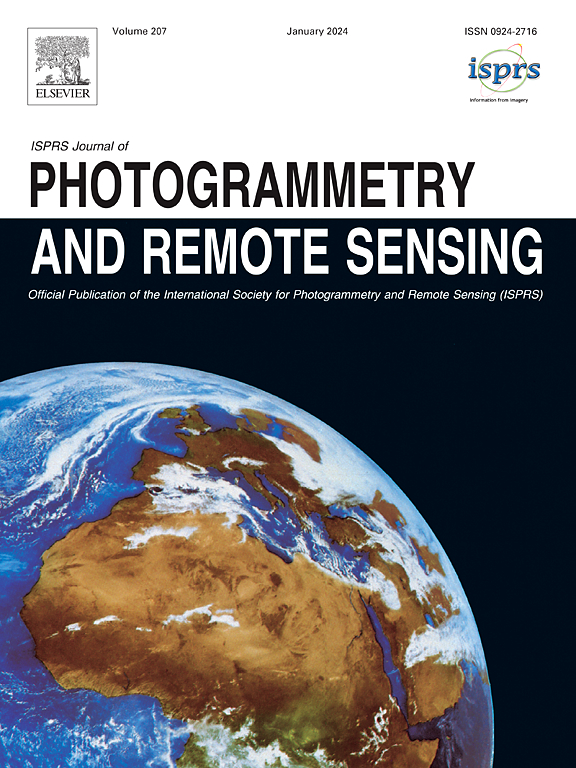Piecewise-ICP: Efficient and robust registration for 4D point clouds in permanent laser scanning
IF 10.6
1区 地球科学
Q1 GEOGRAPHY, PHYSICAL
ISPRS Journal of Photogrammetry and Remote Sensing
Pub Date : 2025-06-27
DOI:10.1016/j.isprsjprs.2025.06.026
引用次数: 0
Abstract
The permanent terrestrial laser scanning (PLS) system has significantly improved the temporal and spatial resolution of surface capture in geomonitoring tasks. Accurate registration of the four-dimensional (3D space + time) point clouds (4DPC) generated by PLS is the prerequisite for subsequent deformation analysis. However, due to the massive data volume and potential changes between scans, achieving automatic, efficient, and robust registration of 4DPC remains challenging, especially in scenarios lacking signalized and reliable targets. To address the challenges in target-free registration of 4DPC from PLS, we propose Piecewise-ICP, a robust and efficient fine registration method. Assuming the stable areas on monitored surfaces are locally planar, we employ supervoxel-based segmentation to generate planar patches from 4DPC. These patches are then refined and classified by comparing defined correspondence distances to a monotonically decreasing distance threshold, thus progressively eliminating unstable areas in an iterative process and preventing convergence to local minima. Subsequently, an improved point-to-plane ICP (Iterative Closest Point) is applied to the centroids of identified stable patches. We introduce the Level of Detection to determine the minimum distance threshold, mitigating the influence of outliers and surface changes on registration accuracy. Based on derived transformation uncertainties, we further smooth the transformation sequence using a Kalman filter, yielding more accurate registration parameters. We demonstrate our registration approach on two datasets: (1) Synthetic point cloud time series with predefined changes and transformation parameters, and (2) a real 4DPC dataset from a PLS system installed in the Alpine region for rockfall monitoring. Experimental results show that Piecewise-ICP improves the average registration accuracy by more than 50% compared to the target-based method and existing robust ICP variants such as Trimmed-ICP and Generalized-ICP.

分段icp:永久激光扫描中4D点云的高效鲁棒配准
永久地面激光扫描(PLS)系统显著提高了地学监测任务中地表捕获的时空分辨率。PLS生成的四维(三维空间+时间)点云(4DPC)的准确配准是后续变形分析的前提。然而,由于庞大的数据量和扫描之间的潜在变化,实现自动、高效和健壮的4DPC配准仍然具有挑战性,特别是在缺乏信号和可靠目标的情况下。为了解决PLS中4DPC的无目标配准问题,我们提出了一种鲁棒高效的精细配准方法分段icp。假设监测表面上的稳定区域是局部平面,我们采用基于超体素的分割方法从4DPC生成平面补丁。然后通过将定义的对应距离与单调减小的距离阈值进行比较,对这些补丁进行细化和分类,从而在迭代过程中逐步消除不稳定区域并防止收敛到局部最小值。随后,将改进的点对平面ICP(迭代最近点)应用于识别出的稳定斑块的质心。我们引入了检测水平来确定最小距离阈值,减轻了异常值和表面变化对配准精度的影响。基于导出的变换不确定性,我们使用卡尔曼滤波进一步平滑变换序列,得到更精确的配准参数。我们在两个数据集上演示了我们的配准方法:(1)具有预定义变化和转换参数的合成点云时间序列,以及(2)安装在高寒地区用于岩崩监测的PLS系统的真实4DPC数据集。实验结果表明,与基于目标的方法和现有的健壮的ICP变体(如Trimmed-ICP和Generalized-ICP)相比,分段ICP的平均配准精度提高了50%以上。
本文章由计算机程序翻译,如有差异,请以英文原文为准。
求助全文
约1分钟内获得全文
求助全文
来源期刊

ISPRS Journal of Photogrammetry and Remote Sensing
工程技术-成像科学与照相技术
CiteScore
21.00
自引率
6.30%
发文量
273
审稿时长
40 days
期刊介绍:
The ISPRS Journal of Photogrammetry and Remote Sensing (P&RS) serves as the official journal of the International Society for Photogrammetry and Remote Sensing (ISPRS). It acts as a platform for scientists and professionals worldwide who are involved in various disciplines that utilize photogrammetry, remote sensing, spatial information systems, computer vision, and related fields. The journal aims to facilitate communication and dissemination of advancements in these disciplines, while also acting as a comprehensive source of reference and archive.
P&RS endeavors to publish high-quality, peer-reviewed research papers that are preferably original and have not been published before. These papers can cover scientific/research, technological development, or application/practical aspects. Additionally, the journal welcomes papers that are based on presentations from ISPRS meetings, as long as they are considered significant contributions to the aforementioned fields.
In particular, P&RS encourages the submission of papers that are of broad scientific interest, showcase innovative applications (especially in emerging fields), have an interdisciplinary focus, discuss topics that have received limited attention in P&RS or related journals, or explore new directions in scientific or professional realms. It is preferred that theoretical papers include practical applications, while papers focusing on systems and applications should include a theoretical background.
 求助内容:
求助内容: 应助结果提醒方式:
应助结果提醒方式:


